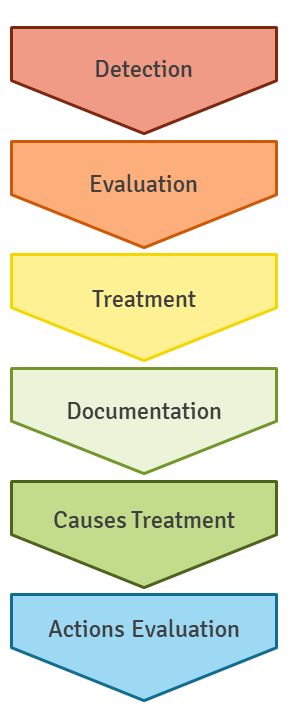Non-conformity
| Non-conformity |
|---|
| See also |
Non-conformity is a failure to meet the requirements. Occurrence of non-conformity decreases quality of product, service or process. The failure can be related to lack of fulfilment of standards, documentation, quality regulations, requirements, contract requirements or customer and other interested parties requirements.
Categories of non-conformity
- Systematic - a failure occurred at least once and can occur more times due to error in system or process structure, for example: dimensions of the product are not being checked during the production process which can lead to manufacturing a number of products with wrong dimensions.
- Random - a failure occurred at least once, but it's related to some random and rare causes, e.g. dimensions of only one product were not checked because of some accident that happened on production line.
Note: Large number of random non-conformities in one area can cause major malfunction of the system.
Non-conformity qualification
- minor or observation - an isolated, non-systematic, proven case of failure to comply with the requirements
- major - a non-systematic failure that seriously declines quality of the product, or systematic failure that has small impact on the product, system or process.
- critical - a defect of the system, systematic or significant number of small non-conformities, that lead to conclusion that important part of the system requires redesign. In case of quality management system it's usually a major flaw in system design (e.g. part of enterprise not included in QMS, failure to meet important requirement of the standard). Critical non-conformity stops the certification process.
Non-conformity management
Non-conformity management is described in management standards (e.g. ISO 9001, ISO 27001, ISO 14001, OHSAS). The main objective of non-conformity management is to deal with detected problem and also deal with its causes to prevent further occurrence.
- Detection. Anyone who detects non-conformity should report it to responsible person as soon as possible.
- Evaluation. The severity of the non-conformity should be evaluated.
- Treatment. All non-conform products should be treated to either remove the non-conformity, decrease its impact or remove the product.
- Documentation. The documentation should include description of the non-conformity, its cause and treatment. It should be a base of further analysis.
- Causes treatment. In case of systematic non-conformities, the causes should be analysed and treated accordingly. The treatment should remove the cause, reduce its impact, reduce its probability or at least implement tools that allow early cause detection.
- Actions evaluation. After completing the activities, their performance should be checked. There should be an objective evidence of full implementation of corrective action and its effectiveness.
Other meanings
Nonconformity is also understood as failure or refusal to conform, as to established customs, attitudes, or ideas. The term in that meaning is wider described in Group conformity article.
References
- ISO 9001 Auditing Practices Group, ISO&IAF, 2005
- Chiarini, A. (2015). Effect of ISO 9001 non-conformity process on cost of poor quality in capital-intensive sectors. International Journal of Quality & Reliability Management, 32(2), 144-155.
- ISO 9001:2015 - Quality Management Systems Requirements
Author: Slawomir Wawak
